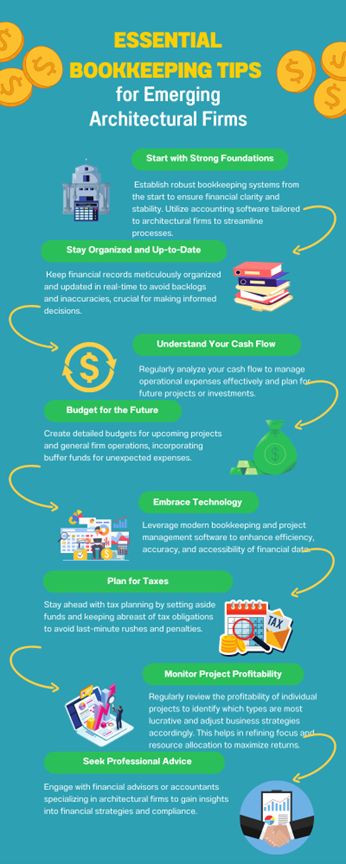
Building Financial Fortitude: Essential Bookkeeping Tips for Emerging Architectural Firms

Think about building a cool treehouse. You need a solid foundation, right? Well, for architecture firms just starting, it’s the same with their money stuff. Keeping track of money with bookkeeping is like laying down strong roots.
It helps them see clearly where their money is going, make smart plans, and keep everything by the book.
Architectural firms, like any business, need solid financial foundations to flourish. Emerging firms must focus not only on design and client relationships but also on the critical aspects of financial management.
Effective bookkeeping enables you to track cash flow, manage resources, and identify the financial health of your projects.
Key Takeaways
- Effective fiscal management is vital for emerging architectural firms.
- Proactive bookkeeping strategies lay the groundwork for business scalability.
- The integration of human insights and advanced tools fortifies financial planning.
Understanding the Basics

In the competitive field of architecture, establishing a robust groundwork in bookkeeping and understanding the key financial statements are crucial steps to ensuring your firm’s long-term financial health and operational clarity.
Bookkeeping is the systematic recording of your architectural firm’s financial transactions. This critical operation serves as the backbone for accurate financial planning and analysis.
By meticulously tracking every expense and income, bookkeeping helps you maintain a clear picture of your firm’s financial standing. Essential tasks include the organization of receipts, the recording of invoices, and the monitoring of cash flow.
Key Financial Statements
Your firm’s financial narratives are told through these core statements:
- Balance Sheet: Reflects your firm’s assets, liabilities, and equity at a specific point in time, offering a snapshot of financial health.
- Income Statement: Sometimes called a Profit & Loss statement, it tracks revenues, expenses, and profit over a period, showcasing operational results.
- Cash Flow Statement: Illustrates how cash enters and leaves your business, highlighting liquidity and your firm’s ability to maintain solvency.
Understanding these statements guides your architectural firm’s financial planning and drives informed decision-making, from budget allocations to strategic investments.
Setting Up Your Financial Framework

To create world-class designs, it’s essential to first establish a solid financial base for your architecture firm.
Ensuring you have the right tools and systems in place is crucial for long-term stability and success.
Choosing the Right Bookkeeping Software
Your choice in bookkeeping software is pivotal. Look for software tailored to the needs of architectural firms, encompassing project management and financial tracking features.
For instance, financial software for architects should streamline invoicing for billable hours and integrate it with other tools you commonly use.
Developing a Chart of Accounts
A well-structured Chart of Accounts (COA) is the backbone of your financial framework. It’s a complete listing of every account in your general ledger, categorized properly.
This categorization should include assets, liabilities, income, expenses, and equity. Your COA sets the stage for accurate monetary management and insightful reporting.
- Assets: Equipment, software licenses, office supplies
- Liabilities: Loans, accounts payable
- Income: Design fees, consultation charges
- Expenses: Rent, utilities, travel
- Equity: Owner’s draw, retained earnings
Separating Personal and Business Finances
It’s essential to distinctly separate personal and business finances. Start by opening a business bank account. This separation will not only help you with accurate bookkeeping but also establish credibility with financial institutions and clients.
It’s one of the first steps recommended for new business owners and plays a significant role in the financial framework for an architecture business.
Bookkeeping Best Practices

Adopting robust bookkeeping practices is vital for your architectural firm’s financial health. Implement these strategies to maintain order in finances and support your firm’s sustained growth.
Regular Reconciliation
You should conduct regular reconciliation of all your accounts to ensure that your financial records match the transactions in your bank statements.
This is critical for catching discrepancies and preventing financial errors. Reconcile your accounts at least monthly to stay on top of any potential issues.
Accurate Expense Tracking
For architectural firms, accurate expense trackingis indispensable. Categorize every expense diligently to keep your financial statements precise.
You might include categories such as software subscriptions, raw materials, and project-specific costs. Use digital tools to track expenses in real-time, allowing you to make informed budgetary decisions.
Invoicing and Payment Collection
Effective invoicing and payment collection can greatly impact your cash flow. Ensure that your invoices clearly detail the services provided and include payment terms.
For prompt payment collection, consider electronic invoicing and online payments, which can streamline the process for you and your clients.
Planning for Profit
To ensure the financial health of your architectural firm, it’s critical to focus on profit planning as a strategic element.
This involves meticulous budgeting, accurate revenue projections, and effective cost management to create a sustainable business model.
Budgeting for Success
Your firm’s steady growth hinges on a well-constructed budget, which delineates all your expected income and expenses over a specific period. Begin with defining your operational costs, from office supplies to software subscriptions.
Incorporate a goal amount representing a portion of your annual operating expenses — a safeguard enabling flexibility and security against unforeseen circumstances.
This should be a tangible target that’s regularly reviewed and adapted to your firm’s financial performance.
Revenue Projection
Revenue projections are a driving factor in your firm’s potential growth and market positioning. Start by analyzing past income patterns, considering both recurring revenue and one-off project fees.
Based on this historical data, you can forecast future earnings using specific factors such as market trends, upcoming projects, and competitive analysis.
Effective revenue projection is not just about optimistic estimations; it should also factor in potential industry downturns and client attrition rates.
Cost Management
A keen eye on cost management is key to maximizing profitability. Listing out all costs—direct and indirect—is essential. Regularly monitor these expenses to identify areas of inefficiency or unnecessary expenditure.
Implement procurement strategies that focus on negotiation and long-term supplier relationships to reduce costs.
Moreover, prudently manage your project-related expenses to ensure they align with client budgets without compromising the quality of your architectural services.
Advanced Bookkeeping Strategies
Building a financially robust architectural firm hinges on mastering advanced bookkeeping strategies.
These strategies not only help ensure tax compliance but also empower you to make informed financial decisions through in-depth analysis of financial data.
Tax Planning and Compliance
To minimize year-end surprises and financial strain, tax planning is essential. As an architect, your firm should:
- Identify potential tax credits and deductions specific to the architecture industry, such as those for sustainable design practices.
- Schedule regular tax assessments to adjust for any changes in tax regulations.
Leveraging Financial Data
Understanding the financial intricacies of your firm gives you a competitive edge.
Here’s how you should approach financial data analysis for architects:
- Regularly analyze project profitability to determine areas where resource allocation can be optimized.
- Use predictive modeling to forecast cash flow and prepare for economic shifts.
By honing these advanced bookkeeping skills, your architectural firm can navigate the complexities of the financial landscape with precision and foresight.
Tools and Resources
In building a resilient financial framework for your architectural firm, the right bookkeeping tools and expert resources are critical assets.
They ensure accuracy, efficiency, and compliance while providing the insight you need for effective financial planning.
Bookkeeping Resources
- Accounting Software: Incorporate robust accounting software that caters to architectural firms, providing features for project-based billing and financial tracking.
Some leading tools offer integration with other systems, such as CRM and project management software, to create a seamless workflow.
- Time-Tracking Tools: Adopt time-tracking tools to record billable hours accurately. Such tools can feed directly into your accounting software, helping you to invoice clients accurately and analyze labor costs against project budgets.
- Financial Templates and Checklists: Utilize checklists such as the essential bookkeeping checklist tailored for small businesses to maintain your financial tasks in order and ensure nothing is overlooked.
- Financial Consultants for Architects: Engage with financial consultants who specialize in architecture. Their expertise can be leveraged to create a robust financial plan that aligns with your business goals and industry standards.
- Online Forums and Communities: Participate in online forums and communities where fellow architects and financial experts share advice, experiences, and best practices within the industry.
Remember, arming your firm with the appropriate resources and consulting with industry-savvy experts can establish a strong base for your financial operations.
Engaging with Your Financial Future
Building financial fortitude is non-negotiable for emerging architectural firms. This engagement means not only understanding but staying ahead in areas like financial compliance and cash flow management.
Staying Updated
You must remain vigilant about the ever-evolving financial regulations that impact your profession. Regularly review updates from authoritative bodies like the American Institute of Architects to ensure your firm’s financial compliance.
By maintaining meticulous records and staying informed, you avoid costly penalties and build a solid reputation for reliability.
Community and Support
Join forums and professional groups to leverage collective knowledge. Engage with peers for insights on effective ash flow strategiesor for navigating complex financial landscapes.
Tools and resources from entities such as the Federal Deposit Insurance Corporation can provide guidance and support to help you manage your firm’s finances efficiently.
Conclusion
As an architectural firm looking to cement a lasting financial legacy, meticulous bookkeeping is fundamental. It shapes the backbone of your business’s financial health and paves the way for resilience and growth.
You are tasked with more than design; you’re building a legacy that transcends time and economic shifts.
Begin by establishing clear financial targets and regularly review your progress. Remember, your legacy is as much about the present as it is about the future. Put systems in place that ensure accurate tracking of cash flow and operational costs. This attention to detail will save you from unforeseen financial hurdles.
Nurture relationships with financial professionals. Their insights will be invaluable in aligning your business strategies with your legacy goals. Whether it’s through wealth management services or personalized advice, choose experts that understand the unique nature of the architectural industry.
Lastly, leverage modern bookkeeping software to automate your financial tasks. This not only increases efficiency but also provides detailed financial reporting—a vital component for decision-making.
Don’t Let Financial Fog Blur Your Firm’s Future
Ever felt lost in the financial maze? It’s a common fear. But what if clarity was just around the corner? At Papillon House, we’re the beacon your business needs.
With our tailored monthly bookkeeping services and tax planning, we illuminate the path to financial confidence.
Forget about navigating the uncertainties alone; let’s clear the fog together. Your firm’s stability and growth are paramount.
Ready to secure a clear financial future? Let Papillon House guide you. Contact now
Frequently Asked Questions
What are the key bookkeeping practices for a newly established architecture firm?
For a new architecture firm, maintaining thorough and accurate records is crucial. Focus on organizing financial documentation and tracking all transactions. It’s essential to categorize expenses and income to understand your financial health.
How should an architectural firm approach creating a solid financial plan?
Creating a robust financial plan calls for setting clear business objectives and forecasting future cash flows. Assessing financial fortitude helps you prepare for economic uncertainties by having a strategy that emphasizes resilience and growth.
What financial statements are most important for an architecture firm’s business model?
Income statements, balance sheets, and cash flow statements are pivotal. These statements provide insight into profitability, financial stability, and liquidity, which are vital metrics for your firm’s long-term success.
What does accounting entail for professionals within the architectural industry?
Accounting for architects extends beyond basic bookkeeping; it includes tracking time accurately to gauge project profitability, managing overhead costs, and ensuring compliance with industry regulations.
What are the best strategies for managing the finances of an architectural firm?
Implementing the best strategies involves regular review of financial plans, employing effective bookkeeping tips, and utilizing technology for financial tracking. Also, consider seeking advice from professionals to navigate complex financial landscapes.
About Morgan

Morgan is the Director at Papillon House Bookkeeping, a Tampa, Florida-based firm that specializes in bookkeeping services for law offices, architects, and the construction industry. With over three years of experience in her current role, she aids her clients in meticulously organizing their financials. Morgan's dedication and expertise extend beyond the realm of accounting, allowing her to provide comprehensive financial management solutions. She also engages with her audience through live discussions on the Papillon House Bookkeeping Facebook group page.




